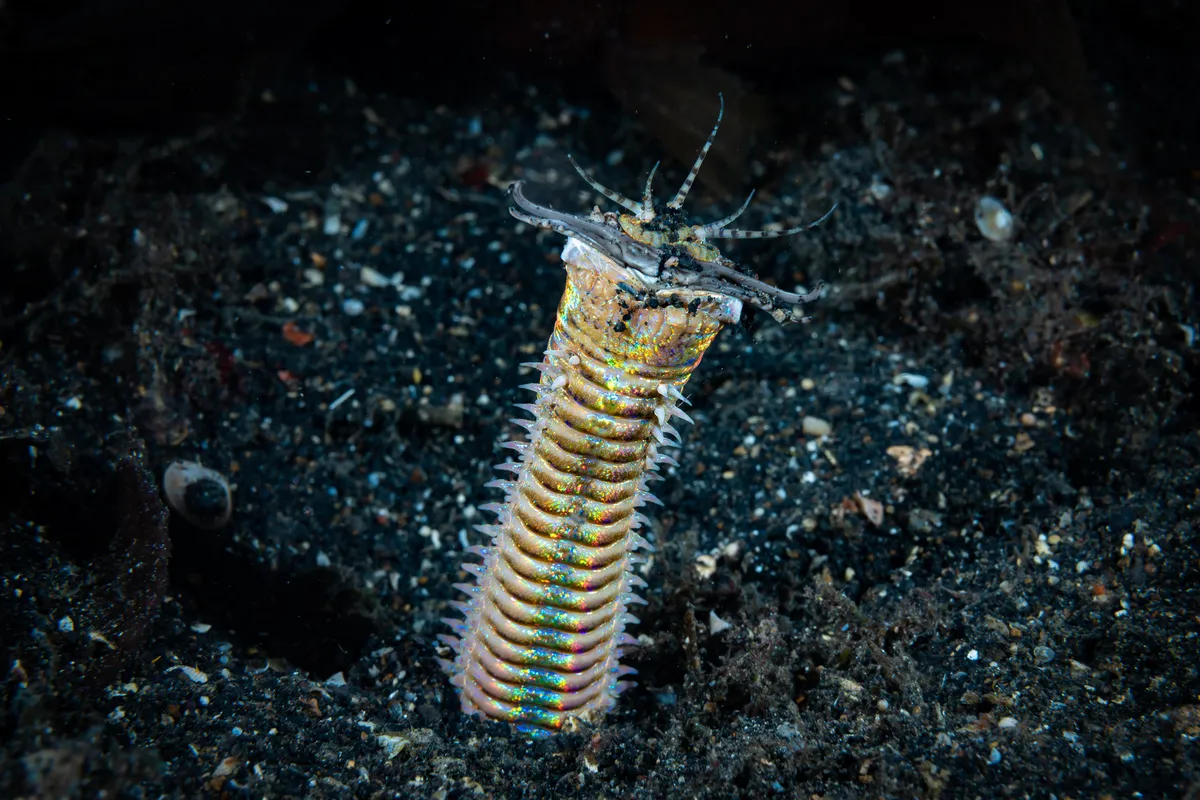When you think of a predator, what do you imagine – a wily wolf or lustrous lion chasing at speed after a wide-eyed deer or terrified gazelle?
That is one way of hunting, but an awful lot of carnivores have a wholly different tactic. They sit and wait. And wait. And wait. It might not be as exciting, but it uses up a lot less energy and it’s highly successful right across the animal kingdom.
- Head-butting, drowning and dive-bombing – discover badass animals that aren't afraid to put up a fight
- Animals that can kill and devour prey twice their size, thanks to either their incredible strength, cunning teamwork or deadly venom
Deadliest ambush predators
Puff adder
Cryptic markings help puff adders (one of the world's most venomous snakes) disappear from view within their arid grassland or semi-desert habitats, enabling their ambush hunting lifestyle.
But they also have another trick up their slinky sleeves – they are the only known terrestrial animals that are chemically camouflaged, too, which means they can’t even be detected by other predators such as mongooses that hunt by sense of smell and would view them as a tasty snack. Most ambush hunters have to hide from their victims – puff adders hide in plain sight.
Stonefish
There are an estimated 1,200 species of venomous fish, but the stonefish (six species have been identified) is regarded as the most lethal – its toxin, discharged through sharp dorsal fin spines, can kill a human in a matter of hours.
They are so-called because their mottled appearance helps them to blend in with stony seabeds where they ambush their prey. Should you ever tread on one, you need to get hold of the anti-venom, but failing that, pouring water of 45˚C over the wound also denatures the poison. Either way, it’s going to hurt.

Leopard
Of all the big cats (leopard, lion, jaguar, snow leopard, tiger), leopards are the most numerous and widespread, found from the west coast of Africa as far east as China – and yet, paradoxically, they may be the hardest to see, the masters of staying out of sight.
This ability allows them to have a unique diet, including large and small antelopes, monkeys, birds – almost anything they can get their claws on. In Mumbai in India, they live alongside millions of people. Attacks on humans are rare, but they do happen.
Black-footed cat
You don’t have to be big to be deadly – the black-footed cat of southern Africa (which is one of the world's smallest cats) is often cited as best in class, with a hunting success rate of 60 per cent, far higher than any of its larger cousins.
Legend has it these feisty felids can bring down a giraffe, and while that isn’t true, they are certainly voracious, catching and eating up to 3,000 prey items a year – almost 10 every night. They will sit patiently for 40 minutes at the entrance to a rodent burrow waiting for a sleepy mouse to stir from its daytime slumbers.
Mantis shrimp
So many of our deadly ambush hunters are remarkably beautiful, and the mantis shrimp (a group of marine crustaceans with hundreds of known species) is no exception – many are brightly coloured and look as if they could attend Rio’s Mardi Gras festival without attracting attention.
But they are also aggressive and highly successful predators, waiting for a hapless victim to come within range before either smashing them with club-like appendages or spearing them with, well, spear-like ones. The acceleration of their weaponry is so great that the resulting shockwave can stun and kill their prey.

Bobbit worm
The dictionary definition of terrifying is “causing extreme fear” but it could equally be “10-foot worm with a lunging set of jaws that lies half-submerged in the seabed”. Known as the bobbit worm, this bizarre relative of the earthworm is truly the stuff of nightmares.
It hangs out around coral reefs and it can attack its prey with such force it chops then in two. Bobbit worms are so good at evading detection that one lived for around 10 years in an aquatics store in Woking – staff had wondered why fish were disappearing, but never suspected there was a deadly assassin right there.

Wolf
Ah, wrong list, you’re thinking. Wolves are classic pursuit hunters, chasing down their prey with, yes, dogged determination. And it’s true, they are – but wolves are such intelligent creatures, they can adapt their behaviour to suit the circumstances.
The idea they can also behave as ambush predators arose when a scientist in Canada videoed a wolf ambushing a beaver, using the vegetation for cover as its target moved from the safety of the river in search of something to eat. The beaver put up a good fight, but this wolf eventually made the kill.
Assassin bug
For some ambush hunters, getting away with it is as crucial as the kill itself, like bank robbers running off with the loot before the cops show up. This is true for assassin bugs, which lures ants with a chemical they find irresistible, before paralysing them with an injection of venom and sucking the insides out. Classy.
But the bug itself is a potential target for jumping spiders, and in order for Acanthaspis petax to keep itself safe, it places the dry husk of the ant’s body onto its back which acts like an invisibility cloak. They can carry up to 20 ant bodies at a time – you can never be too careful. Only the nymphs of this species engage in what's known as 'corpse camouflage' – the adults do not.

Nile crocodile
Almost any crocodilian would serve as an excellent example of an ambush hunter, though the African Nile crocodile is up there with the best. One of the most potent examples of their ruthless efficiency is the crossing of wildebeest at the Mara River, where they lurk unseen in the murky waters as the big moment of their year approaches.
Killing is largely a one, two, three – first the lunge and grab with one of the strongest bites in the animal kingdom, next the death roll to disorient the hapless herbivore, then the coup-de-grace as it is dragged underwater to be drowned.

Sparrowhawk
You don’t have to be exotic or rare to be a deadly ambush hunter. Sparrowhawks are one of the most widespread birds of prey in the world, found all over northern Europe and Asia and even parts of Africa.
They largely rely on surprising their prey with a quick burst of speed from a perch, slamming into their victim (almost always another bird) feet-first such that they can kill on impact. Another common technique is to fly unseen on one side of a hedge before quickly flipping over to the other side to surprise their victims. They are built for extreme manoeuvrability, though it’s said that only 10 per cent of hunts end in a kill.
Amazing wildlife stories from around the world
- “It looked so wrong”: Researchers find never-seen-before footage of capuchins engaging in unprecedented behavior
- Crocodile experts just made a huge discovery in the Caribbean Sea
- The mysterious ‘Asian unicorn’ hasn't been seen since 2013 – here's why scientists are desperate to find it
- “Unbelievable thing to see”: Drone captures never-seen-before footage of penguin chicks plunging 50 feet into Antarctic Ocean
Main image: a Nile crocodile (Crocodylus niloticus) ambushes a wildebeest as it attempts to cross the river during migration in Maasai Mara National Reserve, Kenya. Credit: Getty





